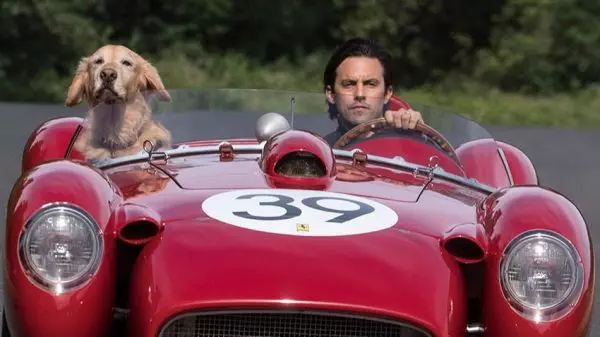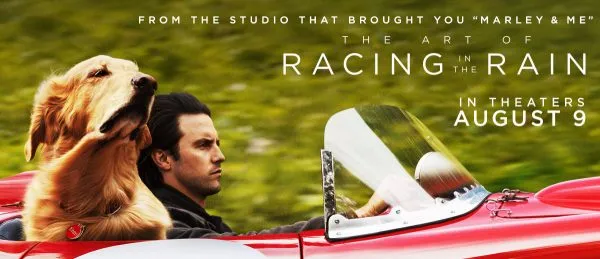How Long Did Garth Stein Take to Write the Art of Racing in the Rain
Justin Melt chats with The Art of Racing in the Pelting writer Garth Stein. The book-to-flick adaptation is available now on digital, Blu-ray and DVD…
Who knew that when Garth Stein published his book The Art of Racing in the Pelting, he'd yet be talking about it over 10 years after its release to promote the home video release of the picture show it spawned. Stein himself even admits that having the book be a part of his life for so many years is "weird."

But, the impact of The Art of Racing in the Rainis undeniable. With over six million copies sold since its release, race auto enthusiasts got a proper racing volume, dog lovers got a quintessential dog book and, even more than than that, readers got an emotionally resonant story that spoke to many on a personal level.
Flickering Myth spoke with Stein virtually what he'southward learned every bit a writer since 2008, his thoughts on the movie, the suggestions he made to the film adaptation'southward managing director Simon Curtis during product and plenty more.
The start thing I wanted to ask was, the book came out in 2008. It spent, I believe, 161 weeks on the New York Times bestseller list and 10 years afterwards hither you lot are talking about its affect and the film that information technology spawned. And so, what'south been like having this volume be a part of your life for so many years?
Garth Stein: It's kind of weird. I gotta be honest with yous. I mean information technology's funny, when I first was writing the volume, I had maybe the first forty pages and I gave them to wife to read, she'due south always my first reader. And I was similar, 'Am I on the correct rail with this?'" And I gave them to her to read and she handed the pages back to me and she said, 'This dog is going to go effectually the globe.' Then she knew correct away what was going on, and that'southward exactly what happened. Information technology's a bully privilege, I totally appreciate it. I've written three other books, which accept done well for books, merely not Enzo numbers. So, I've seen the clouds from both sides and I kind of like this side. It'due south cool to have a book that just keeps going.
And if I'k not mistaken, when you showed your married woman those first 40 pages, she made a suggestion. Am I correct?
Stein: Aye, that's true, yous've heard that story! When I first wrote those 40 pages, Enzo was not named Enzo, he was named Juan Pablo after Juan Pablo Montoya, the race machine driver. I idea information technology was funny, and she was like, 'No.' So, she came upward with Enzo … so I put Enzo in because obviously Enzo Ferrari, simply what's interesting is that there's never a straight connection made between Enzo Ferrari and Enzo the canis familiaris. I left that as an easter egg for people to discover if they know, but past now everybody knows.
How practice you think y'all've changed or evolved as a author since the book came out? Exercise you call back the person that published The Art of Racing in the Rain in 2008 could write information technology in 2019?
Stein: I think and then. I mean, it would be different. The era was a little bit different. A lot of things changed in guild. As far as me as a writer, what I've learned over the years is to really trust my readers. This goes for whatsoever audience — the audition wants to be engaged. The audience is usually pretty smart and they want to figure things out. And what happens a lot of times with younger writers and artists is that they don't believe that the audience is going to 'go information technology,' so they say it again. I tin write with a lot more than economic system at present because I know what my readers are going to 'go,' so I trust them that they're going to figure it out. I don't have to say it three times, I say it one time.
This book is extremely personal to yous and it'southward, of course, a difficult thing handing over your book to a major studio for them to plough it into a movie. Did you have whatever reluctance handing over the ownership of this book that yous spent and then much time with?
Stein: It's a good question. I didn't know what I was doing. I hateful, no 1 paid whatever attention to me earlier The Art of Racing in the Pelting, so suddenly people were paying attending and then this really dainty guy kept on calling me up on my cell telephone and talking to me over and over again, and I'm similar, 'Patrick Dempsy, stop calling me all of the time!' It was kind of absurd … he secured it with Neal Moritz and then it went into 10 years of evolution, which is how it works, correct? At a certain bespeak, I actually believed that in that location was no way they were going to make the movie. I thought it was over. But then, I got a telephone call from a dude with an English accent, Simon Curtis, the director. He [was] similar, (imitation British accent) 'I'm going to exist directing your pic.' And I was like, 'Look, what is happening?' Information technology is weird in a way, but it's an easy metaphor to say it's kind of having a kid. My oldest is 23 and graduated from college last jump, and so, therefore, is living at dwelling right now. There's this journey that you practise with your kids where you're with them and y'all want everything to be perfect, but they have to go into the world on their own at some point and develop their ain relationships. And same affair with a volume in a weird way. It goes out there, and it starts making friends on its own, and information technology starts coming together people that I take nothing to do with, but it'southward always got a place here, with me. I am respectful and beholden of its journey.

Do y'all detect that at that place are certain parts of the book that people respond to emotionally more than they exercise in the motion picture? And are there parts of the flick that people respond to more while reading the volume?
Stein: I know that people respond to unlike things … and then it'south kind of cool to have written something that people can plug into on so many different levels. I really remember that the movie got it right. In that location are changes, there are differences — that'due south fine. The centre of the movie is in the right place and that'south my primary business concern always. In that sense, it's a large success.
I know you weren't directly involved with the movie on-fix, but were in that location whatever places where you stepped into the filmmaking procedure to either request a change or offering another suggestion or steer things in a different management?
Stein: Yes, for sure, I read the scripts every bit information technology went by. I had several conversations with Simon [Curtis] to, sort of, clue him in on what over the years I've noticed are parts of the volume that people love. Little comments that Enzo says. There's the great line where Eve is significant and Enzo presses his faces to her abdomen and feels the animal move inside and he says, 'You know, information technology must be amazing to have a torso that can carry a animate being inside — I mean other than a tapeworm which I've had.' That's a huge laugh line when I read that passage at a reading or something, then things like that I had to say, 'Simon, be certain to put the tapeworm in because people are going to love that.'
So there are a lot of iconic moments in the book that are realized for the big screen in the movie. In particular, what were your thoughts seeing for the beginning time, fully realized on the big screen, Enzo in the car on the racetrack at the end? Because I know you read that chapter at a lot of book readings, and so I know that'southward a particular scene that stands out in the book.
Stein: That is a great scene, and there'south a dramatic inevitability to certain aspects of the story. Information technology goes back to the great Russian playwright Anton Checkov, the gun on the wall theory, which is the same affair with Enzo wanting to be a race car driver. At some point, I knew he was going to have to get into a racecar. Just information technology has to happen. And I didn't know how it was going to happen, merely when I was writing the volume, I felt that I had gotten far plenty that people were going to go with Enzo, and even though information technology was a little contrived to have him strapped into a race auto — you know, it'southward funny that I thought that was kind of wild and crazy, and I got a phone call from a guy named Bob Bondurant, who's a slap-up car racing coach. He taught Steve McQueen and Paul Newman how to drive. So he calls me up from his racing school in Phoenix and he's like, 'Oh, I loved your book! And I take my canis familiaris Rusty out in the race motorcar all the time.' I was like, 'People actually do that! Is that OK?' So it was cool to see it. I will say, just a quick note that they had an animal welfare person at all times on the set, especially when Enzo was in the racecar, making certain that Parker the domestic dog was treated properly and was not undergoing too many G-forces and all that kind of stuff. There was nothing dangerous about it, but it sure was fun to see him in a fancy Ferrari.

In a lot of your work, there's a father-child dynamic that'due south explored. Similar in this book and pic, there'south a father-girl dynamic, and so fifty-fifty in A Sudden Light, information technology explores a father-son dynamic, so what practice you think draws you to those sort of relationships in text?
Stein: Dude, here's the thing: If I knew the answer to that, I would exist a well-adapted person, and I wouldn't write a book!
And then it'due south a mystery to y'all, too!
Stein: I think all writers are grappling with their own internal conflicts in the stuff that they write and office of the fun of it, or part of the therapy of it, is not being also enlightened, and so to answer that I would accept to become introspective, I would have to recollect about my life for a little while, and then I might reveal all sorts of secrets to myself that I don't want to have revealed nearly my relationship with my parents.
It would an impromptu therapy session.
Stein: It's really funny, likewise considering it's manner so true. My first book Raven Stole the Moon is about a adult female whose son dies in a tragic canoeing accident, and How Evan Broke His Head and Other Secrets is too begetter-son based. And then this new book I'one thousand simply turning in chosen A Couple of Quondam Birds nigh an eighty-yr-old woman and her relationship with her developed son. So, all of that stuff is in there and in fact, an editor friend of mine once said to me, 'What happened to you in your childhood.' All of your books are virtually abandonment. And I was like, 'I don't desire to think nigh information technology.'
Can you tell me a little fleck nearly The Cloven, the graphic novel you're working on right at present?
Stein: The Cloven is nearly these mutant goat people, these hybrids that were adult in a cloak-and-dagger laboratory on Vashon Island here in Seattle, and it was an aborted experiment, it went amiss. It was an experimentation in the late 90s. They mothballed the project, but one of the scientists, with a center of gilded, didn't desire his experiments to be euthanized, so he steals all of these little kids who are mutant goat people and lets them go in the Cascade Mountains … and i group of them ends up living underneath the freeway in Seattle. Nosotros have this huge homeless problem in Seattle … Office of what I'm writing is a satire and a commentary on the state of affairs that's going on in Seattle correct now. Merely part of information technology is just, permit'southward take some fun … goats are the funniest things on the planet. And so caprine animal people, have to be by default, funny. We're launching information technology at the Comic-Con in San Diego in July. So I'g really looking forrard to it.

My concluding question, to bring it back to The Art of Racing in the Rain — what did you think of the "Have You Ever Seen the Rain?" needle-driblet at the finish of the movie?
Stein: That cracked me up so much. What they did was they were like, 'We don't want you lot to meet information technology, nosotros don't desire you to see it, we don't desire yous to come across information technology.' I'yard similar, 'C'mon, guys,' and Simon's similar, 'OK, you can run across it at present.' Then they're going to show it to me on April 1st, and I'chiliad petrified. They're like, 'Come downward to the studio, and you lot're going to see it past yourself in this screening room' … And so my number ii son is in higher, down in LA, so I was like, 'You gotta come up with me, hold my manus delight.' So he came and we watched it, and I'm like bawling through this whole thing then at the end that vocal played and I was like, it'south freaking brilliant … "Have You Ever Seen the Rain?," c'mon!
Information technology'due south a perfect bow to wrap up the movie with.
Stein: And I said it, I said it, as well. As soon as the lights came up when the movie was over, Simon was in my face proverb, 'What'd you lot call up.' And I'grand wiping tears away from my eyes, I'one thousand similar, 'Simon, you gotta give me a second here human being.' And then I got myself together and was like, 'That music is brilliant.'
Whether you're a dog lover, racecar enthusiast or fan of the volume, pick yourself up a copy of Simon Curtis' The Art of Racing in the Pelting!

THE ART OF RACING IN THE Rain is a heartfelt tale narrated past a witty and philosophical canis familiaris named Enzo (voiced past Kevin Costner). Through his bond with his owner, Denny Swift (Milo Ventimiglia), an aspiring Formula 1 race car driver, Enzo has gained tremendous insight into the human condition and understands that the techniques needed on the racetrack can also be used to successfully navigate the journey of life. The flick follows Denny and the loves of his life – his married woman, Eve (Amanda Seyfried), their young daughter Zoe (Ryan Kiera Armstrong), and ultimately, his true best friend, Enzo.
Many thanks to Garth Stein for taking the time for this interview.
Justin Melt
Source: https://www.flickeringmyth.com/2019/11/exclusive-interview-the-art-of-racing-in-the-rain-author-garth-stein-shares-his-thoughts-on-the-film-adaptation-and-his-books-enduring-success/
0 Response to "How Long Did Garth Stein Take to Write the Art of Racing in the Rain"
Post a Comment